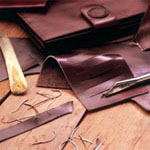Leather Basics - The basic know how about leather pieces
- by Super User

Leather is a material that gets better and more luxurious with age. No other material is so durable as leather, it is easy to care for and natural. Because leather "breathes," it won't pick up on surrounding room temperatures, whether too cold or too hot.
As your leather furniture matures it will crease and soften to look better and become more comfortable the more you use it. Inevitably there are variations in the grain and texture, these are not faults but help to show the authenticity of the real thing
Leather begins with an animal hide that is tanned or preserved. The first quality issue is where leather is taken from the hide. The best leather is always top grain, from the topmost layer of the surface. Less expensive and weaker leathers, including suede, are taken from lower layers or splits of the hide
The quality of leather is also based on the dyeing process. Soft and supple aniline leathers are considered the most luxurious and stylish, but they are not necessarily the most practical option
Aniline is a transparent liquid dye (and natural derivative) used to colour high quality hides. These dyes provide permanent colour that also allows natural grain and markings to show through. Caution: The word "aniline" is used in a couple of ways, which can be confusing when you're just learning
Pure aniline leathers are created from the highest quality top grain. No additional pigment or surface treatments are applied after the dyeing process, so the quality of the leather must be outstanding. Like silk or hand-woven fabric, pure anilines are prized for their natural look and soft hand. Less than 5% of the world's leathers qualify as pure aniline; explaining their high cost
Semi-anilines are soft leathers that are also more practical and easily maintained. In addition to aniline dying, these hides are given added colour and/or protective finishes. Surface corrections are also made to correct imperfections and pigmenting. These are a safer option, but not as heavy duty as corrected grain leathers
Corrected grain leathers are also top grain-but not quite as flawless as the most expensive hides. They are buffed to remove unattractive surface markings before colour pigment is added, then embossed with a natural grain pattern. The resulting surface is somewhat stiffer than pure aniline leather, although it will soften with use
Nubuck and suede are both buffed for a soft, velvety nap, but there's a big difference. Suede is made from splits, so it's a less expensive and less durable leather product. Nubuck is aniline dyed top grain leather, so it lasts longer and shows more natural markings. Because of its nap, Nubuck often receives a protective coating to guard against stains and markings
Suede isn't the only product made from splits. Finishing techniques like embossing or antiquing can be applied to splits to make them resemble top grains. Such leather is less expensive, but does not have the same hand or strength as true top grains



